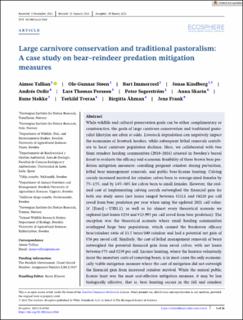| dc.description.abstract | While wildlife and cultural preservation goals can be either complimentary orcounteractive, the goals of large carnivore conservation and traditional pastoralist lifestyles are often at odds. Livestock depredation can negatively impact the economies of livestock herders, while subsequent lethal removals contribute to local carnivore population declines. Here, we collaborated with two Sami reindeer herding communities (2010–2016) situated in Sweden’s boreal forest to evaluate the efficacy and economic feasibility of three brown bear predation mitigation measures: corralling pregnant reindeer during parturition, lethal bear management removals, and public bear-license hunting. Calving corrals increased survival for reindeer calves born to average-sized females by 7%–15%, and by 14%–30% for calves born to small females. However, the realized cost of implementing calving corrals outweighed the financial gain for both our study areas (net losses ranged between €1111 and €6210 per calf saved from bear predation per year when using the updated 2021 calf value; 1€ [Euro] = US$1.1), as well as for almost every theoretical scenario we explored (net losses €234 and €13,995 per calf saved from bear predation). The exception was the theoretical scenario where small herding communities overlapped large bear populations, which crossed the breakeven efficacy bear/reindeer ratio of 13.5 bears/100 reindeer and had a potential net gain of €36 per saved calf. Similarly, the cost of lethal management removals of bears outweighed the potential financial gain from saved calves, with net losses between €75 and €239 per calf. License hunting, where the hunters voluntarily incur the monetary costs of removing bears, is in most cases the only economically viable mitigation measure where the cost of mitigation did not outweigh the financial gain from increased reindeer survival. While the annual public license hunt was the most cost-effective mitigation measure, it may be less biologically effective, that is, bear hunting occurs in the fall and reindeer parturition the following spring which leaves time for the empty niche of harvested bears to be filled by survivors. Economically and biologically effective predation mitigation measures are key for promoting coexistence, and we suggest that potential mitigation measures should be studied in collaboration with local people. brown bear, calving corrals, economic feasibility, management removal, predation, reindeer herding | |
